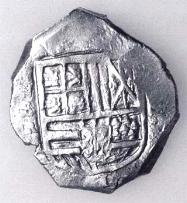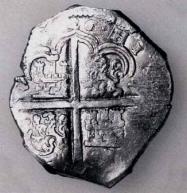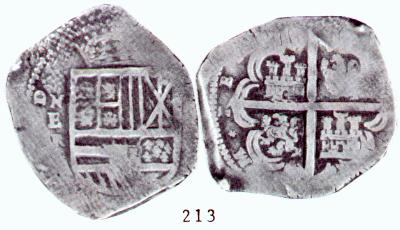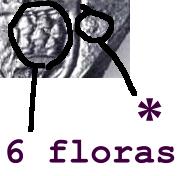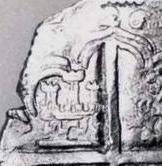
| Philip
IIII / Felipe IIII
8 Reales Assayer / Ensayador E 1626 Cartagena 27.4 grams / gramos. Discovery Coin / Moneda Inedita | ||||
|
Obverse: Habsburg shield with arms of Castile and Leon in correct order, crown above. Value of VIII, not visible on this piece, should be located right of the shield reading downward. Left of the shield is the assayer mark "E" situated between the N and R which is the mint mark NR. The peripheral legend which is not visible on this piece should read: PHILIPPVS IIII DG. Reverse: Cross with castles and lions design in correct order. The legend around reads HI(SPANIARVM REX 16)26. R/L M45-3, L/R M45C-3, C&T Type 347. Anverso: Escudo de Habsburgo coronado con las armas de Castilla y de León en orden correcto. El valor VIII no se alcanza a ver en esta pieza, debería estar localizado a la derecha del escudo orientado de arriba hacia abajo. A la izquierda (del escudo) está la marca de ensayador “E” situada entre la N y la R, que son la marca de ceca NR. La leyenda de la periferia no es visible en este ejemplar sería: PHILIPPVS IIII DG. Reverso: Cruz con castillos y leones en orden correcto. La leyenda alrededor, HI(SPANIARVM REX16)26 R/L M45-13 L/R M45S-3, C&T Tipo 347.
Note / Notese: Dr. Restrepo assigned number M45-6 to this coin.
At the Chicago International Coin Show in 2003, we were privileged to examine this 1626 dated 8 reales from Cartagena, a date previously unpublished. The coin was not for sale at the show.
Tuvimos la fortuna de examinar esta pieza de 8 reales de Cartagena fechada 1626 en la Feria Internacional de Chicago 2003, una fecha inédita. No estaba para la venta.
For Cartagena, Restrepo/Lasser list assayer "E" as working between 1626 and 1635. To this writer's knowledge this is the first Cartagena 8 reales with a date of 1626, although Christensen lists a 1626 4 reales in their 14-May-1982 auction sale.
Restrepo y Lasser anotan al ensayador “E” como activo en Cartagena entre 1626 y 1635. Hasta donde este autor conoce, esta es la primera pieza de 8 reales de Cartagena fechada 1626 aun cuando Christensen publicó una de 4 reales de 1626 en su catálogo de subasta de 1982.
While a 1626 date is previously unknown, this 1626 8R is struck from the same obverse die as lot number 213 in the Christensen Treasures of the Concepción sale 14-May-1982. The reverse is not the identical die but ever so similar, must be almost the same except the bottom lion's foot touches the arc on the 1626 piece but not on the Christensen piece. The Christensen coin is also illustrated on page 108 in the 3rd edition of The Practical Book of Cobs by Daniel and Frank Sedwick.
Aun cuando una moneda de 8 reales con esta fecha no se conocía, este ejemplar fue acuñado con el mismo troquel del anverso que el lote 213 en el catalogo de subasta de Christensen, Tesoros del Concepción del 14 de mayo de 1982. El reverso no proviene de un troquel idéntico pero si muy similar. Solo se diferencia en que el pie del león de la base toca el arco en la pieza de 1626 pero no así en la de Christensen. La pieza de Christensen también aparece ilustrada en “The Practical Book of Cobs por Daniel y Frank Sedwick.
For identification and comparison to other 8 reales we take note of some distinctive features of this type.
Con fines de identificación y comparación con otros ocho reales llamamos la atención sobre algunas características de este tipo:
|
References:
Christensen, Henry, Inc. May 14, 1982 Auction catalog sale 80,
Treasures of the Concepción. Madison, New Jersey.
Restrepo, Dr. Jorge Emilio & Lasser, Joseph R. Macuquinas de
Colombia (The Cobs of Colombia, South America) 110 pp., pub. by author in
Medellín, Colombia 1998.
Sedwick, Daniel & Sedwick, Frank. The Practical Book of Cobs, 130
pp. Third edition, published by author in Orlando, FL., 1995.
Spanish translation courtesy of Dr.
Jorge Emilio Restrepo. / La traducción en el español por la cortesía de Dr. Jorge Emilio Restrepo.
©Copyright Herman Blanton
2003, all
rights reserved.


